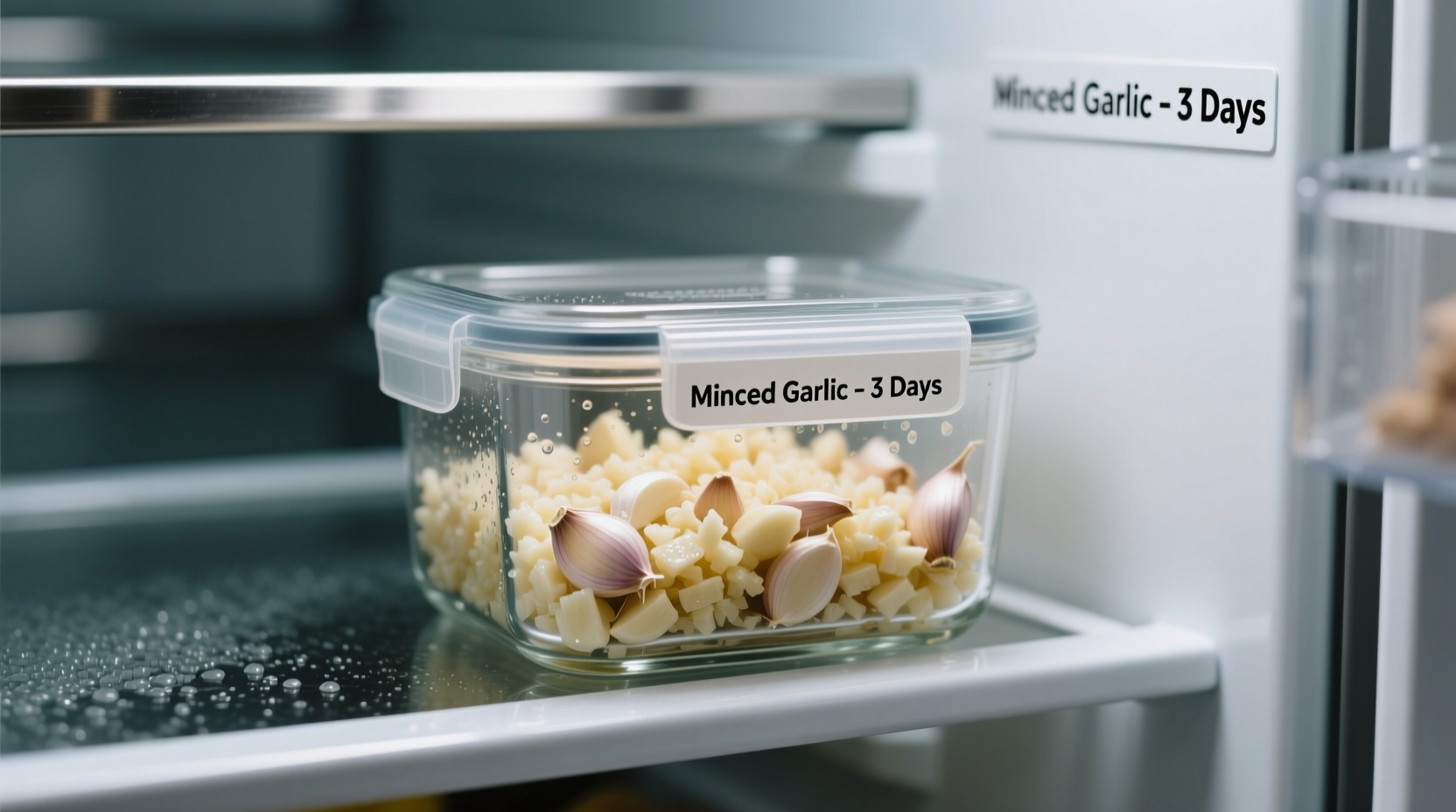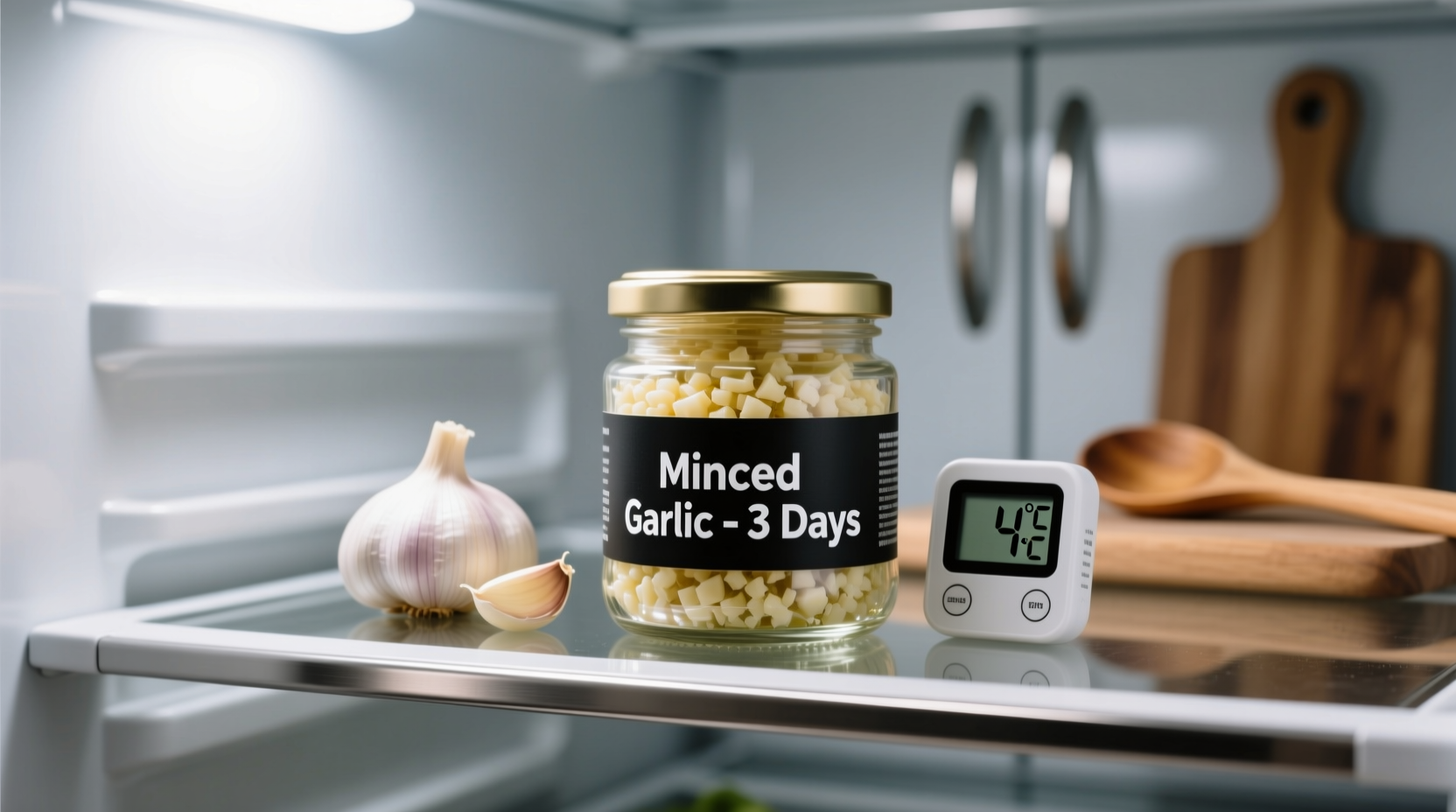Minced garlic stays fresh and safe to eat for 5-7 days when properly stored in an airtight container in the refrigerator at or below 40°F (4°C). This timeframe applies to both homemade and commercially prepared minced garlic once opened.
Ever opened your fridge to find that container of minced garlic you used last week and wondered if it's still safe? You're not alone. Proper food storage is crucial for both safety and flavor preservation, especially with potent ingredients like garlic that can spoil quickly once processed. Getting this wrong could mean wasted food or, worse, foodborne illness.
In this guide, you'll discover exactly how long your minced garlic remains safe in the refrigerator, clear visual indicators that it's gone bad, and professional storage techniques that can maximize its shelf life. We've compiled evidence-based recommendations from food safety experts to ensure you're making informed decisions about this kitchen staple.
What Determines Minced Garlic's Refrigerator Shelf Life
Unlike whole garlic bulbs that can last months, minced garlic has a dramatically shortened lifespan due to increased surface area exposed to air and moisture. When garlic cells are broken during mincing, they release enzymes that accelerate both flavor development and spoilage processes.
The standard 5-7 day recommendation comes from the U.S. Food and Drug Administration's food safety guidelines, which classify minced garlic as a potentially hazardous food due to its moisture content and pH level. Commercial products often contain preservatives that extend this timeframe slightly, but once opened, they follow the same safety parameters as homemade versions.
| Garlic Form | Refrigerator Shelf Life | Freezer Shelf Life |
|---|---|---|
| Whole garlic bulb | 3-6 months | N/A |
| Single peeled clove | 7-10 days | 10-12 months |
| Homemade minced garlic | 5-7 days | 3-4 months |
| Commercial minced garlic (unopened) | Until "best by" date | Not recommended |
| Commercial minced garlic (opened) | 5-7 days | 1-2 months |
Recognizing When Minced Garlic Has Spoiled
Don't rely solely on the calendar—your senses provide the most reliable indicators of spoilage. Here's what to look for when determining if your minced garlic has gone bad:
- Color changes: Fresh minced garlic should be white to pale yellow. If you notice blue, green, or gray discoloration, discard it immediately.
- Texture alterations: Properly stored minced garlic maintains a moist but firm texture. If it becomes slimy, sticky, or develops liquid separation that wasn't present originally, it's time to throw it out.
- Odor deterioration: While garlic naturally has a strong smell, spoiled garlic emits a sour, unpleasant odor distinctly different from its usual pungency.
- Mold growth: Any visible mold, even in small amounts, means the entire container should be discarded as mold spores spread invisibly throughout moist foods.

Maximizing Your Minced Garlic's Freshness
While the standard shelf life is 5-7 days, these professional techniques can help you get the most from your minced garlic:
Proper Storage Containers Matter
The container you use significantly impacts shelf life. Glass containers with tight-sealing lids outperform plastic containers, which can absorb odors and may leach chemicals into acidic foods. For homemade minced garlic, consider adding a thin layer of olive oil on top before sealing—this creates a barrier against oxygen exposure.
Temperature Consistency Is Critical
Your refrigerator should maintain a consistent temperature at or below 40°F (4°C). The door shelves experience more temperature fluctuation than the main compartment, so store your minced garlic on a middle shelf toward the back where temperatures remain most stable. A USDA study on refrigerator safety found that door storage can expose foods to temperatures 10°F warmer than the main compartment during frequent door openings.
Freezing For Extended Storage
If you won't use your minced garlic within a week, freezing preserves both flavor and safety. Portion it into ice cube trays, cover with olive oil, then transfer the frozen cubes to an airtight container. Frozen minced garlic maintains quality for 3-4 months and can be added directly to cooking dishes without thawing.
Important Context Boundaries for Storage Recommendations
While the 5-7 day guideline serves as a reliable standard, several contextual factors can shorten this timeframe:
- Added ingredients: Minced garlic mixed with oil, lemon juice, or other ingredients has a shorter shelf life than plain minced garlic due to additional moisture and potential bacterial growth environments.
- Cross-contamination: Using dirty utensils to scoop garlic introduces bacteria that accelerate spoilage. Always use clean utensils when handling stored garlic.
- Initial freshness: Garlic that was already aging when minced will have a shorter refrigerator life than garlic processed from fresh, firm bulbs.
- Refrigerator conditions: Older refrigerators with inconsistent temperatures or frequent door openings reduce effective shelf life.
Food Safety Considerations With Spoiled Garlic
Consuming spoiled garlic isn't just unpleasant—it can pose serious health risks. Garlic's low acidity creates an ideal environment for Clostridium botulinum, the bacteria that causes botulism, particularly when stored improperly in oil at room temperature. While refrigeration significantly reduces this risk, it doesn't eliminate it entirely after the recommended storage period.
The Centers for Disease Control and Prevention reports that improper home food preservation accounts for approximately 30% of botulism cases in the United States. When in doubt about your minced garlic's freshness, follow the food safety maxim: "When uncertain, throw it out."
Practical Storage Workflow for Home Cooks
Implement this simple routine to maximize both safety and flavor from your minced garlic:
- Label containers: Always note the preparation or opening date on your container
- Store properly: Transfer to an airtight glass container immediately after mincing
- Check regularly: Perform a quick visual and smell check every 2-3 days
- Use first-in-first-out: Place newer containers behind older ones to ensure timely usage
- Freeze extras: Portion and freeze any garlic you won't use within 5 days
When Fresh Garlic Outperforms Minced
For certain culinary applications, fresh garlic cloves provide superior results. Whole cloves maintain their complex flavor compounds longer and work better for roasting, infusing oils, or when you need distinct garlic pieces in your dish. Reserve minced garlic for recipes requiring quick incorporation or uniform flavor distribution.
Frequently Asked Questions
Can I extend minced garlic's shelf life by adding vinegar?
Yes, adding vinegar creates an acidic environment that inhibits bacterial growth, potentially extending shelf life to 2-3 weeks. However, this significantly alters the flavor profile, making it suitable only for recipes where vinegar complements the dish, like salad dressings or marinades.
Why does my minced garlic turn green in the refrigerator?
Green discoloration occurs when garlic enzymes react with acids or certain metals. While not always dangerous, it often indicates the garlic is past its prime. If accompanied by off odors or sliminess, discard it immediately. This reaction happens more frequently in younger garlic harvested early in the season.
Is it safe to freeze unopened commercial minced garlic?
Freezing unopened commercial minced garlic is generally safe but not recommended. The preservatives and packaging are designed for refrigerator storage, and freezing can alter texture and cause separation. For best quality, follow the manufacturer's storage instructions and freeze only after opening if you won't use it within the recommended timeframe.
How can I tell if jarred minced garlic is still good after the "best by" date?
"Best by" dates indicate peak quality, not safety. Unopened jarred garlic typically remains safe for 1-2 months past this date if stored properly. After opening, follow the 5-7 day rule regardless of the printed date. Always check for off odors, discoloration, or bubbling before use, as these indicate spoilage.











 浙公网安备
33010002000092号
浙公网安备
33010002000092号 浙B2-20120091-4
浙B2-20120091-4